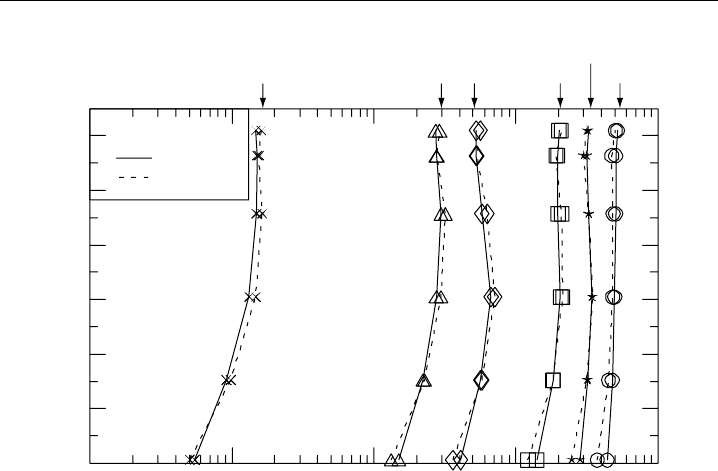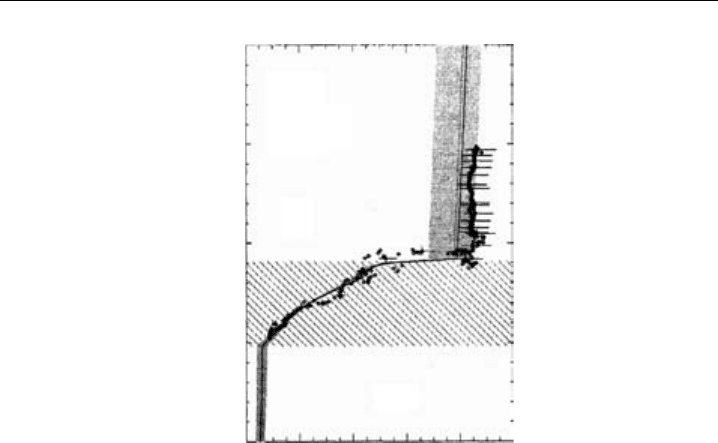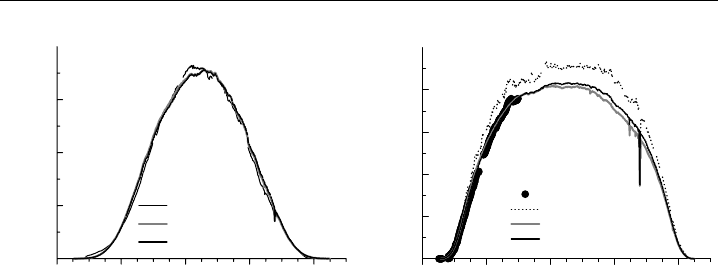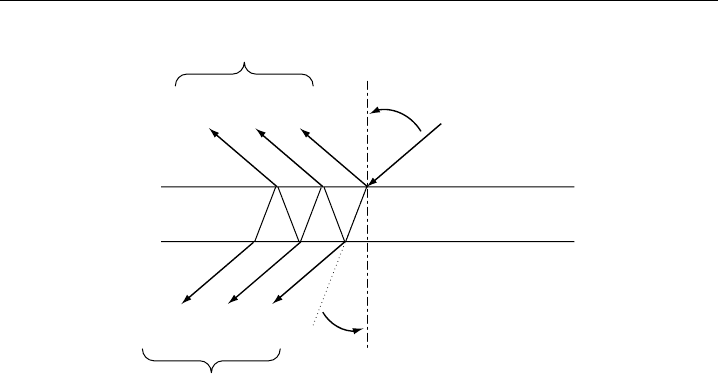Heard D.E. (editor) Analytical Techniques for Atmospheric Measurement
Подождите немного. Документ загружается.


478 Analytical Techniques for Atmospheric Measurement
298 nm 305 nm 310 nm 325 nm
380
nm
420
nm
10
11
25 25
Actinic flux (photons cm
–2
nm
–1
s
–1
)
25 2510
12
10
13
10
14
10
15
0
2
4
6
8
10
12
10 June
Measured
Simulated
Altitude (km)
Figure 9.41 Measured and simulated vertical profiles of the actinic flux over the Agean Sea in Greece
for selected wavelengths on a cloudless day (10 June, 1996). The solar zenith angle was between 17
and
23
during the flight measurements (adapted from Hofzumahaus et al., 2002, printed with permission
from American Geophysical Union).
in Figure 9.42. A strong reduction of measured jNO
2
values caused by an optically
thick cloud layer was observed in the lowest troposphere. The gradual jNO
2
decrease in
the cloud layer is well described by model simulations which used micrometeorological
measurements of cloud droplets and particles as model input. When compared to clear-
sky conditions, an increase of the actinic flux above clouds and a strong decrease below
clouds can be expected (Madronich, 1987b; Van Weele & Duykerke, 1993). Measurements
have shown, for example, enhancements above clouds as high as +200% and attenuations
below clouds up to −90% (Lefer et al., 2003). While the influence of closed cloud layers
on the actinic flux can be described consistently by one-dimensional RT models, the
effect of broken clouds cannot be well represented by the same models (Kylling et al.,
2005). Here, more research is needed to better understand the three-dimensional effects
of clouds on the radiation field.
9.8.3 Instrumental intercomparisons
The performance of actinic-flux-sensitive measurement instruments was investigated in
various field comparisons. Radiometry-based techniques were tested against chemical
actinometers for jO
1
D (Müller et al., 1995; Hofzumahaus et al., 2004) and jNO
2
(Kraus et al., 1998, 2000; Shetter et al., 2003). Other investigations involved radiometric

Measurement of Photolysis Frequencies in the Atmosphere 479
j (NO
2
) (10
–3
s
–1
)
Height (km)
2.0
1.5
1.0
0.5
0.0
0246810
Figure 9.42 Vertical profile of jNO
2
(symbols) measured by a broadband filter radiometer near
Dresden, Germany, on a cloudy day (9 December, 1996) at a solar zenith angle =74
. The solid and
dotted lines represent simulations with two different radiative transfer models. The cross-hatched area
indicates an optically thick cloud layer (adapted from Früh et al., 2000, printed with permission from
American Geophysical Union).
techniques only, comparing spectrally resolved actinic fluxes (e.g. Webb et al., 2002b;
Bais et al., 2003; Edwards & Monks, 2003; Eckstein et al., 2003) or results for jO
1
D and
jNO
2
(e.g. Kraus & Hofzumahaus, 1998; Lefer et al., 2001; Eckstein et al., 2003; Kanaya
et al., 2003).
The most comprehensive field comparison so far, the International Photolysis
Frequency Measurement and Modeling Comparison (IPMMI), was performed in Boulder,
Colorado, on four days with cloudy and clear-sky conditions in summer 1998 (see
overview by Cantrell et al., 2003). The assessment was carried out as a blind inter-
comparison that included chemical actinometers, spectroradiometers, and broadband
filter radiometers from eight international research groups. Some examples of diurnal
profiles of jO
1
D and jNO
2
measured by actinic-flux spectroradiometers and chemical
actinometers on a clear day are shown in Figure 9.43.
The main results of the experimental data assessment can be summarised as follows:
•
Actinic-flux measurements were compared for three spectroradiometers. Two double-
monochromator instruments agreed to within ±6% independent of solar zenith angle
and wavelength (300–420 nm) when the measurements were transformed to a common
spectral resolution. A third spectroradiometer which was based on a single monochro-
mator showed significant disagreements (up to 30%) with the two other spectrora-
diometers as a result of instrumental stray light. For further details, see Bais et al.
(2003); Edwards and Monks (2003).

480 Analytical Techniques for Atmospheric Measurement
48 812 16 20
0
1
2
3
4
CA-NCAR
SR-NCAR
SR-FZJ
Daytime (MDT)
4121620
0
2
4
6
8
CA-NCAR
CA-UMD
SR-NCAR
SR-FZJ
Daytime (MDT)
j (NO
2
) (10
–3
s
–1
)
j
O(
1
D) (10
–5
s
–1
)
Figure 9.43 Comparison of diurnal profiles of photolysis frequencies measured by different chemical
actinometers (CA) and actinic-flux spectroradiometers (SR) during the IPMMI field campaign in Boulder,
Colorado, on 19 June 1998 (Shetter et al., 2003; Hofzumahaus et al., 2004). The cross sections and
quantum yields used for the evaluation of the spectroradiometer data are in agreement with the IUPAC
recommendations from 2004 (Atkinson et al., 2004).
•
General good agreement for jO
1
D within 10% was found among filter radiometers and
spectroradiometers at solar zenith angles less than 60
, provided that the instruments
used the same cross sections and quantum yields. The deviations were generally larger
(up to a factor of 2) when the zenith angles were larger than 60
. Two spectroradiometers
and one filter radiometer showed excellent agreement within 5% with the chemical
actinometer for zenith angles less than 80
, when recently published O
1
D quantum
yield data were used and when the temperature dependence of jO
1
D was explicitly
taken into account. For further details, see Hofzumahaus et al. (2004).
•
Measurements of jNO
2
from filter radiometers, spectroradiometers and two chemical
actinometers showed consistent agreement within the stated instrumental uncer-
tainties (from 8 to 20%) at zenith angles below 70
. Spectroradiometers and chemical
actinometers agreed within less than 10% when more recent NO
2
absorption cross
sections from the literature were used. Filter radiometers appeared to be generally less
accurate, with larger discrepancies (20–50%) at larger zenith angles above 70
. For
further details, see Shetter et al. (2003).
9.8.4 Molecular data assessments
The determination of photolysis frequencies from radiation spectra requires absorption
cross sections T and quantum yields T of the photodissociation reactions
of interest. In general, there is a choice between published molecular data from different
research studies that sometimes show discrepancies larger than their specified uncer-
tainties. This is of considerable relevance in actinic-flux spectroradiometry, because the
absorption cross sections and quantum yields make the largest contribution to the error
of derived photolysis frequencies (Kraus & Hofzumahaus, 1998; Cantrell et al., 2003) (see
also Table 9.6). For a decision on which data are most suitable and accurate, it is generally
a good idea to consult the recommendations which are periodically published and

Measurement of Photolysis Frequencies in the Atmosphere 481
updated by institutions like the Jet Propulsion Laboratory (JPL) under contract of the
American National Aeronautics and Space Administration (NASA) or the Subcommittee
on Gas Kinetic Data Evaluation for Atmospheric Chemistry of the International Union
on Pure and Applied Chemistry (IUPAC). Both institutions make their own evalua-
tions available via the World Wide Web (http://jpldataeval.jpl.nasa.gov and www.iupac-
kinetic.ch.cam.ac.uk).
For the two most important tropospheric photolysis frequencies, jO
1
D and jNO
2
,
the accuracy of the molecular data was explicitly tested in field experiments by comparing
chemical actinometer measurements against photolysis frequency data that were derived
from measured actinic-flux spectra and different sets of absorption spectra and quantum
yields (Müller et al., 1995; Shetter et al., 1996; Kraus et al., 2000; Cantrell et al., 2003;
Shetter et al., 2003; Hofzumahaus et al., 2004).
9.8.4.1 Ozone photodissociation
The most comprehensive study for jO
1
D was performed in the IPMMI field campaign
(see Section 9.8.3) over a temperature range of 5–45
C and zenith angles from 165
to 90
(Cantrell et al., 2003; Hofzumahaus et al., 2004). The derived jO
1
D data were
found to have little sensitivity <3% to the choice of literature ozone absorption cross
sections, which were chosen for example from Bass and Paur (1985), Molina and Molina
(1986), and Malicet et al. (1995). A large sensitivity, however, was found to be the choice
of O
1
D quantum yields which were taken from different releases of the NASA/JPL
recommendations from 1994 to 2003. Compared to chemical actinometry, the differences
in the derived jO
1
D values were generally found to increase with the solar zenith angle.
The largest differences were observed in case of the recommendation from 1994 (DeMore
et al., 1994), yielding discrepancies over a factor of 2 at low sun > 70
. The application
of the most recent recommendation for the O
1
D quantum yield (Matsumi et al., 2002;
Sander et al., 2003; Atkinson et al., 2004) gave the best absolute agreement between
chemical actinometry and spectroradiometry, with very small systematic deviations (<5%)
at zenith angles <80
(Figure 9.43). These deviations were smaller than the specified
instrumental uncertainty (10%) of the chemical actinometer used for the study.
9.8.4.2 Nitrogen dioxide photodissociation
The cross sections and quantum yields of the NO
2
photolysis were tested in two field
studies, JCOM97 (Kraus et al., 2000) and IPMMI (Cantrell et al., 2003; Shetter et al.,
2003). The use of absorption cross sections (Davidson et al., 1988) and quantum yields
(Gardner et al., 1987; Roehl et al., 1994) recommended by NASA/JPL (DeMore et al.,
1997; Sander et al., 2003) led in both studies to spectroradiometer results that were
consistently higher than the chemical actinometer measurements by 10–20%. Improved
agreement with deviations generally less than 10% was obtained in both studies when
IUPAC recommended data (Atkinson et al., 2004) were applied, favouring more recent
measurements of the absorption cross sections in accord with the Merienne et al. (1995)
data and revised quantum yields from Troe (2000).

482 Analytical Techniques for Atmospheric Measurement
9.9 Conclusions and outlook
Various experimental techniques are now available for routine measurements of
atmospheric photolysis frequencies. The most direct method is chemical actinometry,
which has been applied in field campaigns almost exclusively for the photolysis of O
3
and NO
2
. It is calibrated by a gas-phase standard and has the particular advantage that it
does not require the knowledge of cross sections and quantum yields. The requirement to
handle pressurised gases and the instrumental difficulty of detection of reactive photolysis
products is probably the reason why it is not more widely used for other photolysis
reactions.
The most versatile method is actinic-flux spectroradiometry. It measures the spectrally
resolved actinic flux and can be used to determine photolysis frequencies of a variety
of chemical compounds from the same measured radiation spectrum. As a further
advantage, the absolute calibration is traceable to very accurate radiation standards
from national laboratories. For the determination of photolysis frequencies, the method
requires knowledge of absorption cross sections and quantum yields. Although the
relevant photochemical data have been measured thoroughly, they remain the largest
source of uncertainty in the calculation of photolysis frequencies.
The quality of photochemical data for O
3
and NO
2
has been improved greatly owing
to new laboratory studies. The improvement is consistent with the outcome of field
comparisons between chemical actinometry and actinic-flux spectroradiometry, which
agree well when the applied cross sections and quantum yields comply with the most
recent IUPAC recommendations (Atkinson et al., 2004). The comparisons also demon-
strate that jO
1
D and jNO
2
can be measured with spectroradiometers as accurate as by
chemical actinometers.
In the future it would be desirable to test critically the photochemical database for other
important molecules, like formaldehyde, and perform corresponding field comparisons
with chemical actinometers.
Broadband filter radiometers are useful, because they are small and can be run
automatically with high time resolution. However, their calibration is laborious and their
data evaluation requires careful corrections for their imperfect spectral matching of the
respective photolysis processes.
Spectroradiometers developed at the time of writing are based on multichannel-detector
spectrograph systems. They combine the advantages of spectroradiometry with the small
size and high time resolution known from filter radiometers. Spectrograph instruments
offer the largest potential for field studies; however, unsolved stray light problems preclude
at present their usefulness in the UV-B region. Their further development will significantly
facilitate the fast measurement of actinic radiation and photolysis frequencies, in particular
on aircraft and under cloudy conditions.
Acknowledgements
The author gratefully acknowledges fruitful cooperation with present and previous co-
workers and colleagues in the field of photolysis frequency measurements, in particular
Birger Bohn, Theo Brauers, Alexander Kraus, Martin Müller, and Franz Rohrer;

Measurement of Photolysis Frequencies in the Atmosphere 483
furthermore Arve Kylling, Christos Zerefos, Rick Shetter and the colleagues who
contributed to the IPMMI project, and Rainer Schmitt at Meteorologie Consult GmbH.
He also likes to thank Gus Hancock for the stimulating and fruitful collaboration on the
photolysis of ozone. Many thanks to Birger Bohn for critical reading of the manuscript
and Dwayne Heard for his encouragement in writing this chapter.
Appendix
A.1 Radiation quantities and their relationships
Basic properties of radiance, irradiance, and actinic flux and their relations relevant for
the determination of atmospheric photolysis frequencies have been discussed for example
by Madronich (1987b) and Van Weele et al. (1995). This section summarises some of
the important relationships.
The radiance in the atmosphere can be split into three components:
L
= L
0
+L ↓+L ↑ (A.1)
where L
0
is the spectral radiance of the direct sunlight, L ↓ represents the downwelling
diffuse sky radiation, and L ↑ describes the upwelling diffuse radiation. When
equation A.1 is inserted into equation 9.10, the actinic flux can be partitioned accordingly
into a direct flux F
0
, a diffuse downwelling flux F ↓, and a diffuse upwelling flux F ↑:
F
= F
0
+F ↓+F ↑ (A.2)
In a similar way, the downward irradiance (cf. equation 9.14) can be written as the sum
of the direct downward irradiance E
0
and the diffuse downward irradiance E ↓:
E
= E
0
+E ↓ (A.3)
The upward directed irradiance E ↑ is related to the downward irradiance by a surface
albedo A
s
, which is defined as:
A
s
=
E ↑
E
0
+E ↓
(A.4)
By definition the direct actinic flux F
0
is related to the direct irradiance E
0
by the cosine
of the solar zenith angle :
F
0
E
0
=
1
cos
(A.5)
Ratios can also be defined for the upwelling and downwelling diffuse components:
r
dd
=
F ↓
E ↓
=
L ↓ d
L ↓ cos d
(A.6)
r
du
=
F ↑
E ↑
=
L ↑ d
L ↑ cos d
(A.7)

484 Analytical Techniques for Atmospheric Measurement
Here, the ratios r
dd
and r
du
can be calculated only if the angular distribution for the
corresponding diffuse radiance is known.
Inserting equations A.4–A.7 into equation A.2 allows to express F
in terms of the
downwelling direct and diffuse irrandiance components:
F
=
E
0
cos
+r
dd
E ↓+r
du
A
s
E
0
+E ↓ (A.8)
Next the parameter
E
is defined as the direct fraction of the total downward irradiance:
E
=
E
0
E
0
+E ↓
=
E
0
E
(A.9)
Combining Eqs. A.8 and A.9, a general relationship between F
and E
can be derived:
F
E
=
E
cos
+r
dd
1 −
E
+r
du
A
s
=
E
1
cos
−r
dd
+
r
dd
+r
du
A
s
(A.10)
It is often assumed that the reflecting surface giving rise to the upward directed radiance
behaves like a Lambertian reflector, that is produces upward radiance without angular
dependence. For this special case (isotropy assumption) r
du
is calculated to be
r
du
=
F ↑
E ↑
= 2 (A.11)
Then equation A.10 assumes the following form:
F
E
=
E
1
cos
−r
dd
+
r
dd
+2A
s
(A.12)
This is the basic equation for estimating actinic fluxes from downward irradiances above
Lambertian surfaces with albedo A
s
.
Another useful equation can be derived from equations A.4 and A.7 for the upward
actinic flux F ↑ above Lambertian surfaces r
du
= 2:
F ↑= 2A
s
E
0
+E ↓ (A.13)
Inserting equations A.5 and A.6, one finds:
F ↑= 2A
s
cosF
0
+
1
r
dd
F ↓ (A.14)
Assuming a nearly isotropic distribution for the downward radiance L ↓ yields
r
dd
=
F ↓
E ↓
= 2 (A.15)

Measurement of Photolysis Frequencies in the Atmosphere 485
and
F ↑= A
s
2cosF
0
+F ↓ (A.16)
When the parameter
F
is defined as the direct fraction of the total downward actinic
flux
F
=
F
0
F
0
+F ↓
(A.17)
and is inserted into equation A.16, the following relation between the upward and
downward actinic flux is found:
F
=
F ↑
F
0
+F ↓
= A
s
F
2cos −1 +1
(A.18)
Here, the ratio
F
, applicable to actinic fluxes, is the formal counterpart to the albedo
A
s
which is defined for irradiances and can be used to estimate F ↑ from the total
downwelling actinic flux. Besides an albedo A
s
the estimate requires values for the solar
zenith angle and the fraction
F
of the direct actinic flux. A detailed discussion of
reflected actinic fluxes and their relevance above ground and cloud surfaces has been
given by Madronich (1987b).
A.2 Effective transmission of solar radiation into a chemical
actinometer
We consider the effective transmission of ultraviolet and visible solar radiation into the
photolysis cell of a chemical actinometer as discussed in Section 9.3.3. It is assumed
that the photolysis cell is either a spherical bulb or an infinitely long cylindrical tube
with non-absorbing walls made of quartz. The wall thickness is assumed to be small
compared with the radius of the cell. Under the latter assumption, the reactor wall will
behave approximately like a plane-parallel plate at the point at which an incident light
ray penetrates into the interior of the reactor.
An appreciable amount of incident light is lost by reflections at the two interfaces of the
wall, when the radiation enters the photolysis reactor. The reflectance at each interface
between air and quartz depends on the refractive indices (n
1
and n
2
) of the two media,
the angle of incidence
1
and the polarisation of light. For the polarisation component
parallel and perpendicular ⊥ to the plane of incidence (the plane containing a ray
incident on the surface and the normal of the surface at the point of incidence), can
be calculated according to Fresnel’s formulas (McCluney, 1994):
=
n
1
cos
2
−n
2
cos
1
n
1
cos
2
+n
2
cos
1
2
and
⊥
=
n
1
cos
1
−n
2
cos
2
n
1
cos
1
+n
2
cos
2
2
(A.19)
Here
2
is the angle of the refracted light ray in the quartz and is related to
1
by Snell’s
law
n
1
sin
1
= n
2
sin
2
(A.20)

486 Analytical Techniques for Atmospheric Measurement
The reflectances of both polarisation components are equal in the case of normal
incidence
1
=0
. With n
1
=1 (air) and n
2
=146 −15 (quartz at = 650−250 nm),
the reflectance is about 3.8% at each interface. For grazing incidence
1
→ 90
, the
reflectances both approach 100%.
The effective reflectance R and transmittance T of a plane-parallel plate of quartz
surrounded by air is the result of multiple reflections at the two interfaces of the plate
(McCluney, 1994). Consider an incident ray of light, with intensity I
0
denoting the flux
of photons carried by the ray (Figure 9.44). At the first air–quartz interface, part of the
light will be reflected with intensity I
0
R
= ×I
0
, while the remaining fraction 1 − ×I
0
will be refracted into the quartz. Part of the refracted light will be transmitted through
the second interface, leaving the quartz as a ray of intensity I
0
T
= 1 −
2
×I
0
, with a
direction that is collinear to the original light. The radiation that is not transmitted at the
second interface will undergo successive internal reflections in the quartz plate, each with
reflectance . On each reflection, a fraction 1 − of light will escape from the plate into
the air. As a result, an infinite number of rays with intensities I
0
T
I
1
T
I
2
T
I
i
T
i →
will be transmitted through the quartz plate, adding up to the total intensity I
T
. The
intensities can be written as
I
0
T
= I
0
1 −
2
I
1
T
= I
0
1 −
2
2
etc
I
i
T
= I
0
1 −
2
2i
(A.21)
I
T
=
i=0
I
i
T
= I
0
1 −
2
i=0
2i
(A.22)
For x ≤1, the following relation is valid
i=0
x
2i
=
1
1 −x
2
(A.23)
so that
T =
I
T
I
0
=
1 −
2
1 −
2
=
1 −
1 +
(A.24)
In a similar way, a succession of rays with the intensities I
0
R
I
1
R
I
2
R
I
i
R
i → will be
reflected with total intensity I
R
. For reasons of energy conservation, I
R
must be equal to
I
0
−I
T
. It follows that
R =
I
R
I
0
=
2
1 +
(A.25)
Equations A.24 and A.25 are applicable to light with parallel or vertical polarisation by
setting =
or =
⊥
, respectively. Unpolarised light can be treated as the superimpo-
sition of two components with parallel and perpendicular polarisation. The transmitted

Measurement of Photolysis Frequencies in the Atmosphere 487
I
0
ϑ
1
I
R
0
I
R
1
I
R
2
I
T
0
I
T
1
I
T
2
I
T
I
R
n
2
n
1
n
1
ϑ
2
Figure 9.44 Illustration of multiple reflections at the two interfaces of a plane-parallel plate. n
2
denotes
the refractive index of the transparent plate material (e.g. quartz) and n
1
= 1 is the refractive index of
the surrounding air. I
0
is the intensity of the incident light ray, I
R
and I
T
are the total intensities of the
reflected and transmitted rays, respectively.
1
is the angle of incidence and
2
the angle of refraction
of the original ray.
(reflected) intensities are determined separately for each of the two polarisation compo-
nents, which finally add up to the total transmitted (reflected) intensity. Note that
Equations A.24 and A.25 are valid only for non-coherent light, like solar radiation. The
treatment of coherent, monochromatic radiation must take into account interference
effects which play no role for broadband radiation.
Next we consider the sun light that has penetrated into the interior of the photolysis
reactor. The transmitted ray with intensity I
1
=1−R×I
0
is collinear to the original ray
I
0
, which has an angle of incidence
0
(Figure 9.9). The ray I
1
strikes the interior wall
surface at an angle which is essentially equal to
0
, if the wall thickness is small, compared
with the radius of the reactor. The interior reflection of I
1
produces a succession of an
infinite number of reflected rays with intensities I
2
I
3
I
4
, etc. Each of these rays has the
same angle of incidence at the interior wall and the same path length like ray I
1
. The
collective contribution of all interior rays to the photolysis in the actinometer is therefore
given by
I
internal
=
i=1
I
i
(A.26)
with
I
1
= I
0
1 −R
I
2
= I
0
1 −RR
etc
I
i
= I
0
1 −RR
i
(A.27)
